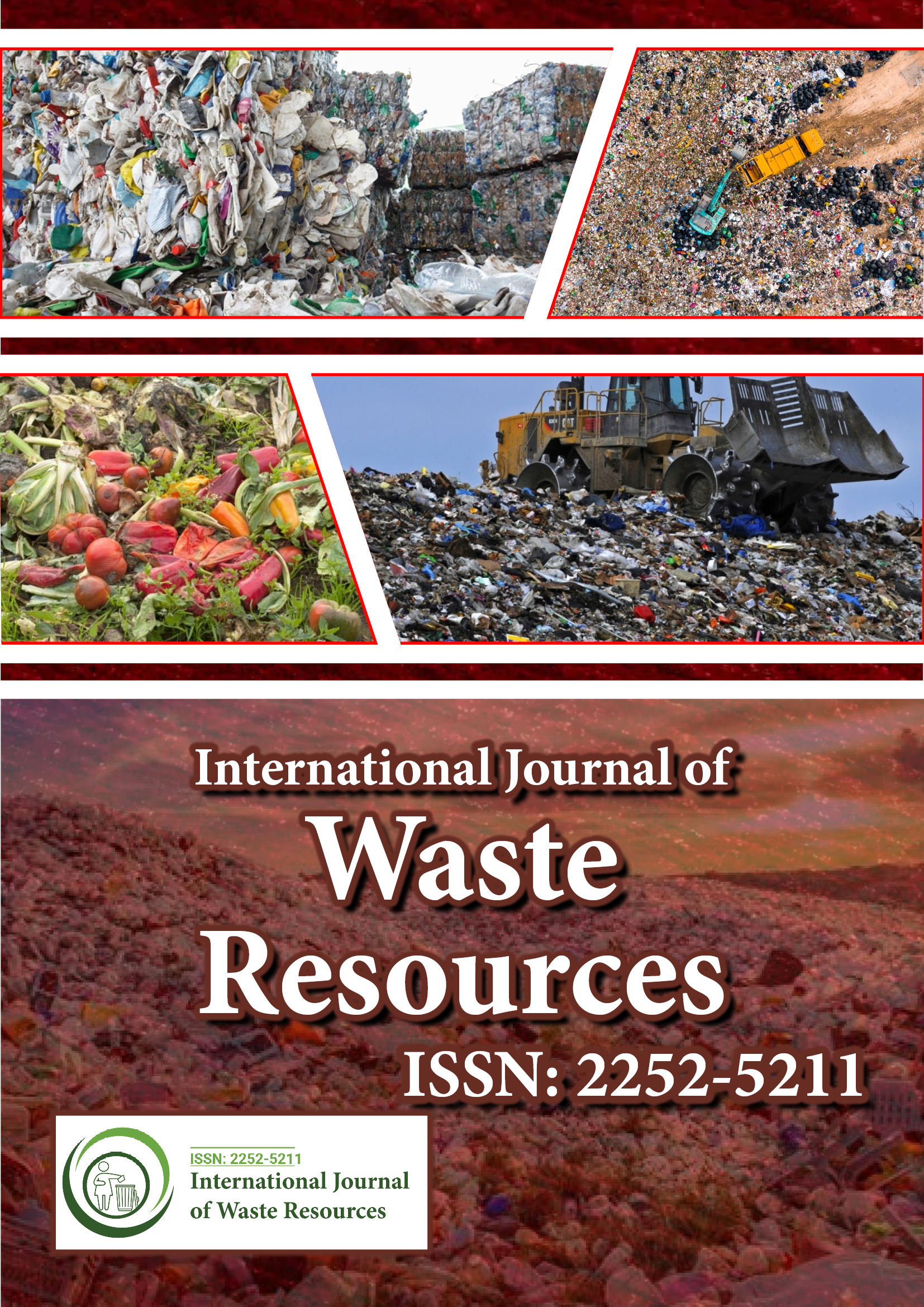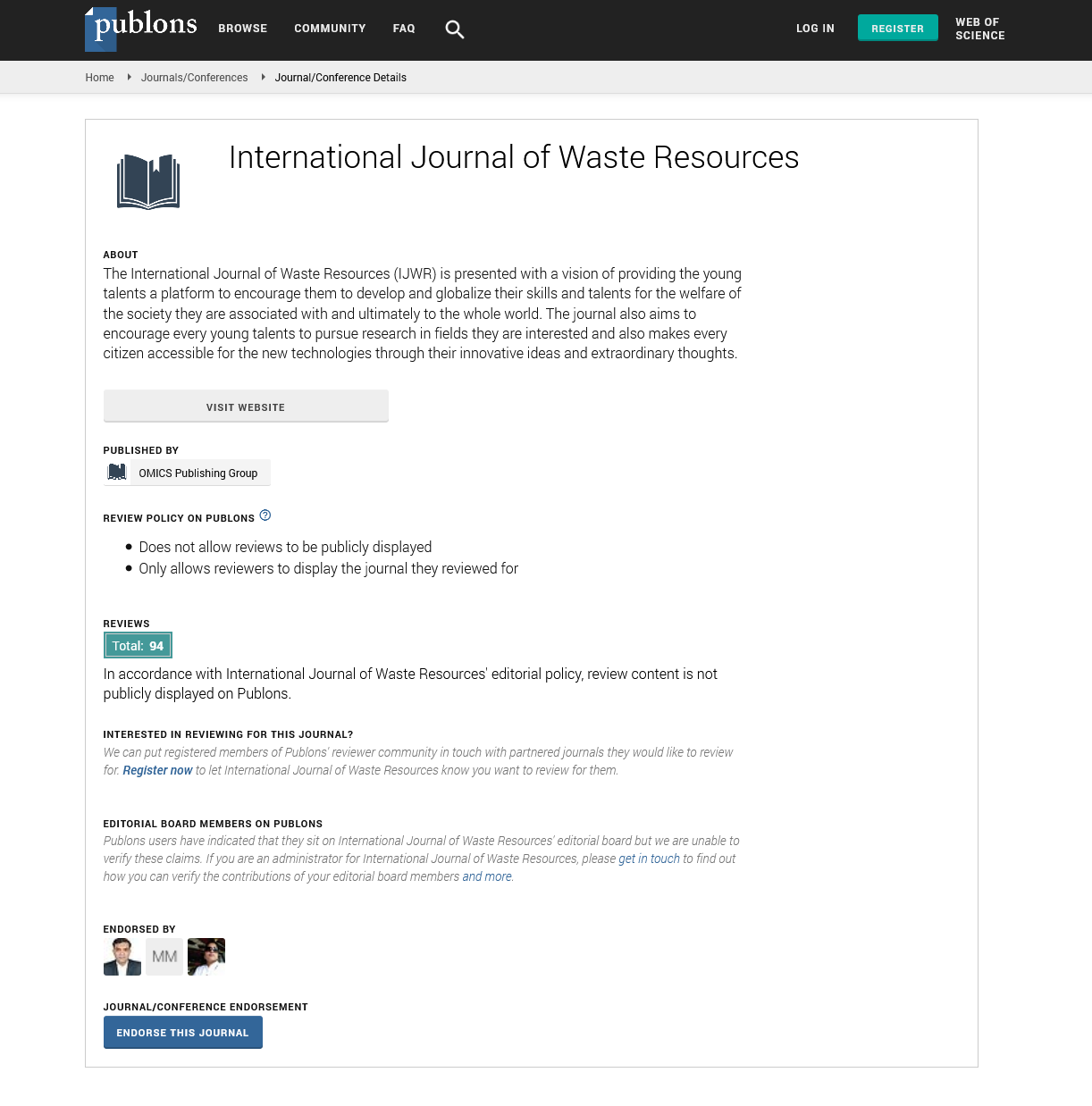Indexed In
- Open J Gate
- The Global Impact Factor (GIF)
- Open Archive Initiative
- VieSearch
- International Society of Universal Research in Sciences
- China National Knowledge Infrastructure (CNKI)
- CiteFactor
- Scimago
- Ulrich's Periodicals Directory
- Electronic Journals Library
- RefSeek
- Directory of Research Journal Indexing (DRJI)
- Hamdard University
- EBSCO A-Z
- Publons
- Google Scholar
Useful Links
Share This Page
Journal Flyer

Open Access Journals
- Agri and Aquaculture
- Biochemistry
- Bioinformatics & Systems Biology
- Business & Management
- Chemistry
- Clinical Sciences
- Engineering
- Food & Nutrition
- General Science
- Genetics & Molecular Biology
- Immunology & Microbiology
- Medical Sciences
- Neuroscience & Psychology
- Nursing & Health Care
- Pharmaceutical Sciences
Commentary - (2025) Volume 15, Issue 2
Specific Waste Management Areas: Types, Methods, Infrastructure, Policies, and Environmental Considerations
Antonella Petrillo*Received: 30-Apr-2025, Manuscript No. IJWR-25-29428; Editor assigned: 02-May-2025, Pre QC No. IJWR-25-29428; Reviewed: 16-May-2025, QC No. IJWR-25-29428; Revised: 23-May-2025, Manuscript No. IJWR-25-29428; Published: 30-May-2025, DOI: 10.35248/2252-5211.25.15.611
Description
Specific waste management areas refer to the targeted and specialized handling, treatment and disposal of distinct categories of waste generated across various sectors of society. Unlike general waste management, which deals with everyday household and municipal solid waste, specific waste management addresses waste streams that require specialized techniques due to their composition, hazards, or potential for environmental contamination. These include medical waste, hazardous waste, e-waste, agricultural waste, construction and demolition waste, industrial waste and radioactive waste. Effective management in each of these areas is essential to prevent public health risks, environmental pollution and long-term ecological damage.
Medical or healthcare waste consists of materials generated by hospitals, clinics, laboratories and related institutions. It includes used syringes, bandages, body fluids, pharmaceutical residues and surgical instruments. This type of waste poses biological and chemical hazards and must be segregated at the point of generation into categories such as infectious, sharps, pathological and pharmaceutical waste. Treatment methods typically involve autoclaving, incineration, or chemical disinfection, followed by secure landfill disposal for residues. Poor handling of medical waste can result in disease transmission, environmental contamination and occupational hazards for healthcare workers and waste handlers.
Hazardous waste comprises substances that are toxic, flammable, corrosive, or reactive. These include chemicals from manufacturing processes, solvents, batteries, paints, pesticides and some household cleaning products. Managing hazardous waste requires strict regulatory oversight, beginning with classification and labeling, followed by secure containment, transportation, treatment and disposal. Treatment options may include chemical neutralization, encapsulation, high-temperature incineration, or deep-well injection. Inappropriate disposal can lead to soil, air and groundwater contamination, harming both ecosystems and human health.
Electronic waste, or e-waste, is another rapidly growing waste stream due to the increased consumption of electronic devices. E-waste includes discarded computers, smartphones, televisions, printers and other consumer electronics. These items contain valuable materials such as gold, copper and rare earth metals, as well as hazardous substances like lead, mercury and cadmium. Proper management involves collection, dismantling, material recovery and safe recycling or disposal of non-recyclable components. Informal e-waste recycling, common in some countries, often leads to severe environmental pollution and health risks due to unsafe handling and open burning of toxic materials.
Agricultural waste includes plant residues, animal manure and agrochemical containers. This type of waste is generated through farming, livestock raising and food processing activities. While much of it is biodegradable, improper disposal can lead to water contamination, greenhouse gas emissions and soil degradation. Composting and anaerobic digestion are sustainable methods of managing organic agricultural waste, converting it into nutrient-rich fertilizer and biogas. Plastic packaging and chemical containers, however, require specific collection and recycling systems to avoid environmental damage.
Construction and Demolition (C and D) waste originates from building, renovating, or demolishing structures. It includes concrete, wood, metal, drywall, bricks and asphalt. C and D waste represents a significant portion of the total waste stream in many countries. Effective management involves source separation, reuse of building materials, on-site sorting and recycling of concrete and metals. Some materials, such as asbestos-containing insulation, require special handling due to their hazardous nature. By reducing landfill use and conserving raw materials, C and D waste management contributes to sustainable urban development.
Industrial waste is produced by manufacturing and production processes across various sectors including chemicals, textiles, food processing and energy production. It may be hazardous or non-hazardous and requires tailored strategies depending on the type of waste generated. Process optimization, waste minimization, recycling within production systems and secure disposal are key strategies. Regulatory frameworks often require industries to maintain detailed records of waste generation, treatment and disposal, along with environmental monitoring and reporting.
Radioactive waste is generated from nuclear power plants, medical procedures, research institutions and some industrial activities. This waste is classified into low-level, intermediate-level and high-level waste, based on its radioactivity and half-life. Management of radioactive waste is highly regulated and involves secure containment, shielding and long-term isolation from the environment. Low-level waste may be disposed of in engineered landfills, while high-level waste is typically stored in deep geological repositories. The long-term safety of radioactive waste disposal remains a critical concern for public policy and environmental protection.
Effective waste management in specific areas relies on a combination of infrastructure, regulatory systems, public awareness and technological solutions. Segregation at source, standardized labeling, safe transportation and proper worker training are foundational to minimizing risks. Waste tracking systems, treatment facilities and certified disposal sites ensure compliance and transparency. Government policies and international conventions, such as the Basel Convention on hazardous waste movement, establish legal frameworks to guide and enforce proper waste management practices.
Economic considerations also play a significant role in determining how specific waste streams are managed. Investment in advanced treatment technologies, monitoring systems and recycling infrastructure can be substantial, but the long-term benefits include reduced environmental damage, resource conservation and improved public health. Economic incentives, such as tax breaks for recycling, subsidies for waste treatment facilities, or penalties for illegal dumping, are often employed to encourage responsible behavior among industries and consumers.
Public education and stakeholder engagement are essential for the success of specific waste management programs. Communities must be informed about proper disposal methods, the dangers of improper handling and the environmental importance of compliance. Outreach initiatives, school programs and collaboration with non-governmental organizations can raise awareness and foster responsible behavior.
Conclusion
In conclusion, specific waste management areas require tailored approaches due to the unique characteristics and hazards of different waste types. From medical and hazardous waste to ewaste and radioactive materials, effective management demands specialized techniques, infrastructure, regulations and community involvement. As global waste production continues to rise, investing in advanced waste management systems and promoting sustainable practices will be vital for safeguarding human health, preserving natural resources and ensuring environmental sustainability for future generations.
Citation: Petrillo A (2025) Specific Waste Management Areas: Types, Methods, Infrastructure, Policies and Environmental Considerations. Int J Waste Resour: 15:611.
Copyright: © 2025 Petrillo A. This is an open-access article distributed under the terms of the Creative Commons Attribution License, which permits unrestricted use, distribution and reproduction in any medium, provided the original author and source are credited.

